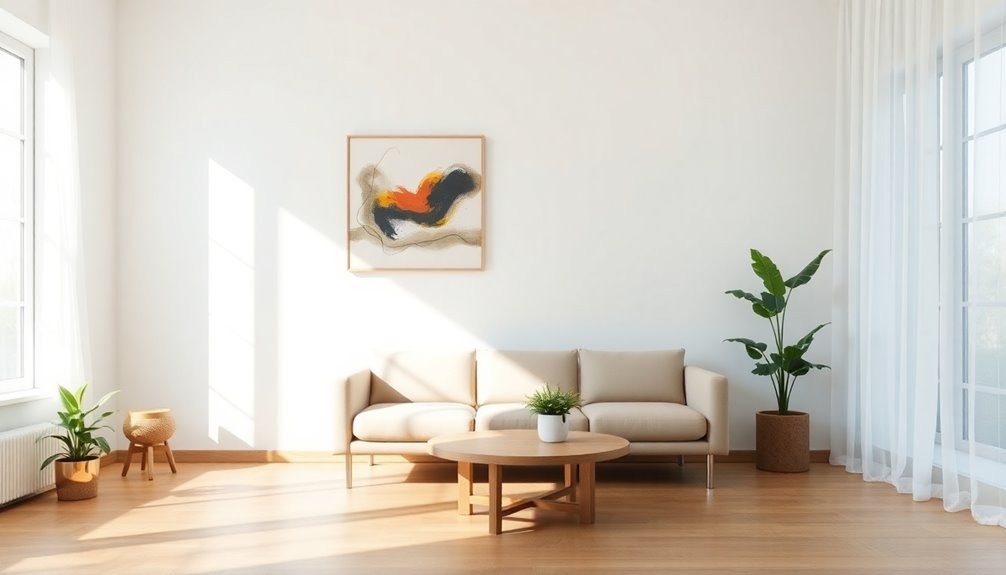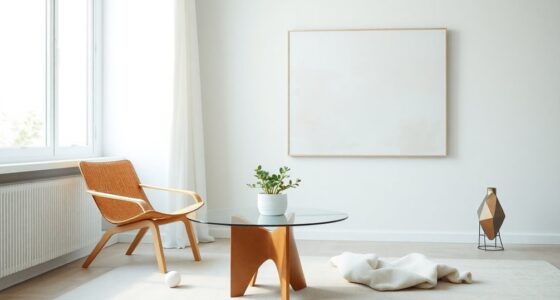Minimalism is reshaping interior design trends by prioritizing simplicity and functionality. You'll notice a shift towards neutral color palettes and clean lines, creating serene environments. Designers focus on using natural materials, promoting sustainability and a connection to nature. Multi-functional furniture maximizes space efficiency, perfect for modern living. This approach reduces clutter and fosters inviting spaces. Keep exploring to discover more about how minimalism can transform your living environment.
Key Takeaways
- Minimalism emphasizes functionality, reshaping living spaces to prioritize usability and practicality in interior design.
- Neutral color palettes and clean lines create serene environments, influencing color choices and design aesthetics.
- The use of natural materials, like wood and stone, promotes sustainability and eco-consciousness in modern decor.
- Multifunctional furniture is increasingly popular, maximizing space efficiency and catering to diverse lifestyle needs.
- Minimalist design encourages open floor plans, fostering social interaction and enhancing the flow of natural light indoors.
Understanding Minimalist Interior Design Principles
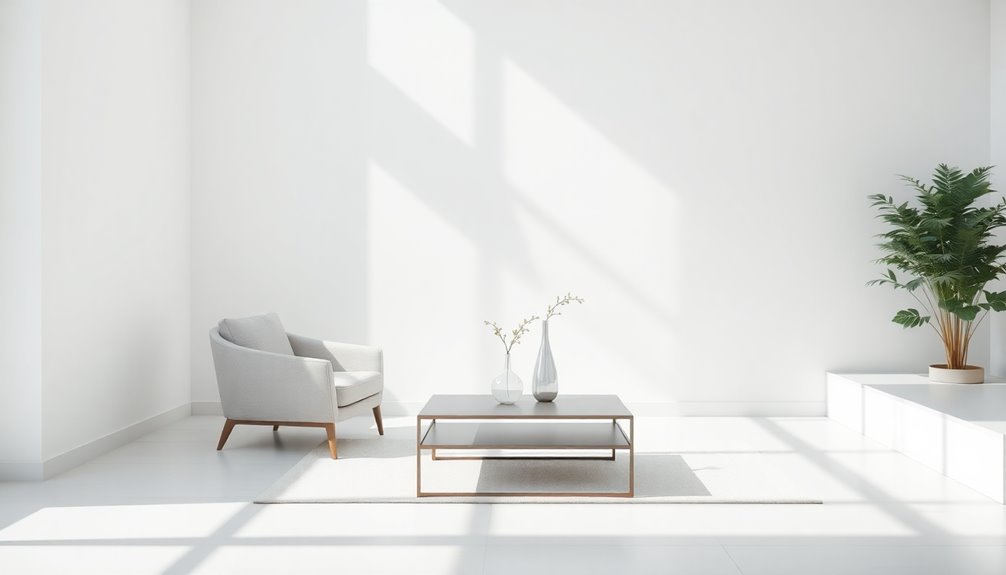
When you embrace minimalist interior design, you'll discover a revitalizing approach that prioritizes simplicity and functionality. This style embodies the "less is more" philosophy, focusing on open spaces and clean lines that create a calming atmosphere.
A neutral color palette, featuring shades of white, beige, and gray, enhances the feeling of spaciousness and tranquility in your home. Functionality is key; every element should serve a purpose, emphasizing quality over quantity.
You can maximize space efficiency with multi-functional furniture, like sofa beds and storage ottomans, making it perfect for smaller areas. Additionally, minimalist design promotes sustainable living by advocating for the use of natural materials and durable, eco-friendly options, reducing your environmental impact while maintaining aesthetic appeal.
The Impact of Minimalism on Home Decor Trends

As you explore the impact of minimalism on home decor trends, you'll find that this design philosophy reshapes how we approach our living spaces.
Emphasizing the "less is more" concept, minimalism in interior design prioritizes functional furnishings over excessive items. You'll notice neutral colors and clean lines creating serene spaces that enhance natural light.
The use of natural materials like wood and stone promotes sustainable interior design and a connection to nature. Multifunctional furniture, such as storage coffee tables and sofa beds, maximizes space efficiency, particularly in smaller urban environments. Additionally, the incorporation of natural elements fosters tranquility, aligning well with minimalist aesthetics.
Benefits of Adopting a Minimalist Approach
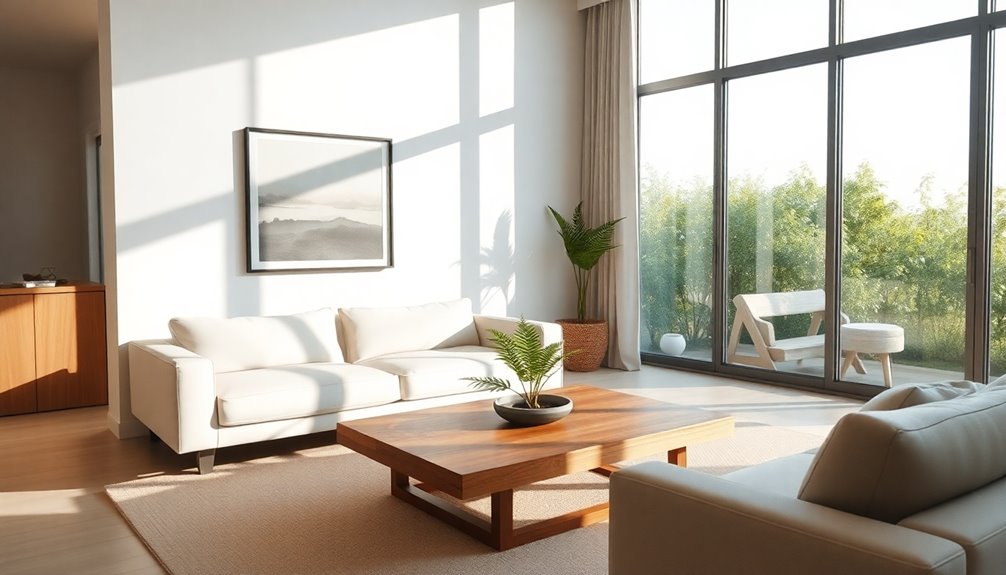
Embracing a minimalist approach in interior design offers numerous benefits that can transform your living space. By reducing clutter, you enhance focus and productivity, creating a serene atmosphere that fosters mental well-being. Minimalism emphasizes clean lines and neutral color palettes, making your interior feel larger and brighter. Using natural materials, you not only elevate the aesthetics but also promote sustainable practices, encouraging mindful consumption. Additionally, incorporating natural materials from the Balinese design philosophy can enhance the warmth and tranquility of your minimalist space.
| Benefit | Description |
|---|---|
| Enhanced Focus | Eliminates distractions, improving productivity. |
| Visual Interest | Clean lines and neutral tones create inviting spaces. |
| Space Efficiency | Multifunctional furniture maximizes usability. |
Adopting Minimalism can lead to a more peaceful, beautiful, and sustainable living environment.
Sustainable Practices in Minimalist Design
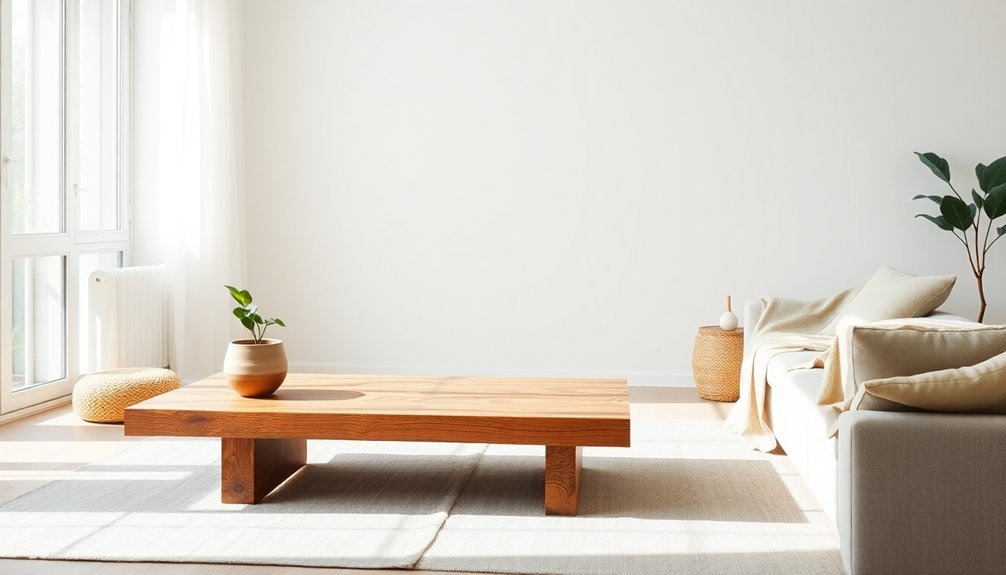
Minimalist design champions simplicity and intentionality, making it an ideal approach for sustainable living. By focusing on eco-friendly practices, you reduce consumerism and waste.
Prioritizing natural materials like wood, stone, and organic textiles not only enhances your space's aesthetic but also lowers your environmental impact.
In a minimalist design, you embrace quality over quantity, investing in durable items that last longer, minimizing the need for replacements.
Sustainable brands like Maiden Home and West Elm reflect these principles, offering products that support eco-conscious living.
Adopting a decluttered lifestyle fosters mindful consumption, allowing you to make intentional purchasing decisions that align with your values.
With minimalist design, you create a sustainable home that feels both serene and purposeful. Additionally, incorporating energy-efficient systems can further reduce your home's environmental footprint while enhancing comfort.
Embracing Functionality Through Minimalism
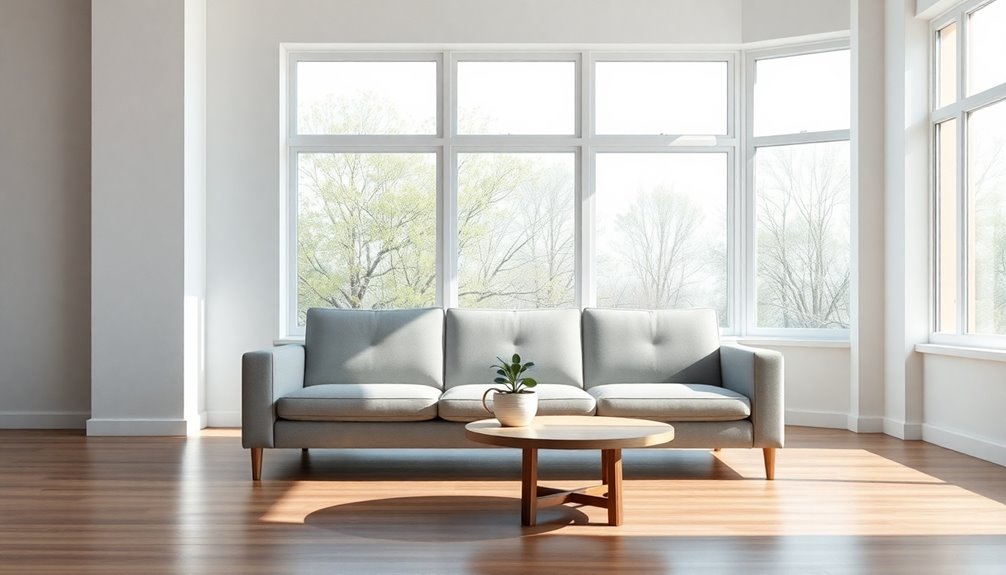
When you prioritize functionality in your home, minimalism naturally follows as a guiding principle. By embracing minimalist designs, you can create interior spaces that are both practical and visually appealing.
Invest in multifunctional furniture like sofa beds and storage coffee tables to maximize utility without sacrificing style. Open floor plans enhance social interaction while making your space feel larger and more inviting.
To maintain a clutter-free environment, implement clever storage solutions such as built-in shelving and hidden cabinets. Remember to choose quality over quantity; durable items serve a purpose and elevate your decor.
Finally, let natural light in through large windows with minimal treatments, connecting your home to the outdoors and enriching the atmosphere. Additionally, regularly assess and rotate items to prevent clutter buildup and ensure your space remains functional and serene.
Frequently Asked Questions
Why Is Minimalist Interior Design so Popular?
Minimalist interior design's popularity stems from its ability to create serene spaces that reduce stress in your hectic life.
You appreciate the idea of "less is more," focusing on quality over quantity in your purchases. The neutral color palettes and natural materials foster a calming atmosphere, while multifunctional furniture adapts to your smaller living areas.
Plus, embracing minimalism aligns with sustainable living, allowing you to make mindful choices that benefit both you and the environment.
What Is the Minimalist Interior Design Trend?
The minimalist interior design trend emphasizes simplicity and functionality.
You'll notice a focus on clean lines, neutral colors, and natural materials, creating a serene atmosphere in your space.
This approach encourages you to declutter and display only essential items, adhering to the "less is more" philosophy.
Multifunctional furniture becomes key, maximizing efficiency and promoting a lifestyle that values quality over quantity, making your home both stylish and sustainable.
How Does the Concept of Minimalism Influence Our Design Choices?
Minimalism influences your design choices by encouraging you to prioritize essential elements while eliminating clutter.
You'll find yourself drawn to neutral color palettes and natural materials that create a calming atmosphere.
Choosing multifunctional furniture allows you to maximize space without sacrificing style.
This intentional approach not only fosters a serene environment but also promotes mindful consumption, leading you to invest in high-quality, durable items that align with a sustainable lifestyle.
Why Minimalism Is Trending?
Minimalism's trending because you're increasingly valuing experiences over stuff.
You crave simplicity in your living space, especially with urban life pushing you into smaller apartments. By decluttering, you maximize your space and create a calming environment.
Plus, neutral colors and natural materials resonate with your desire for eco-friendly choices.
The psychological benefits of a tidy space, like reduced stress and improved focus, make minimalism an appealing lifestyle shift for you.
Conclusion
As you embrace minimalism in your home, you'll find that simplicity breeds clarity, both in design and in life. The unexpected beauty of fewer possessions allows you to appreciate what truly matters, coinciding with a growing awareness of sustainability. By prioritizing functionality and intentionality, your space transforms into a serene sanctuary that reflects your values. In this journey, you'll discover that less really can be more, enriching your experience in ways you never anticipated.
